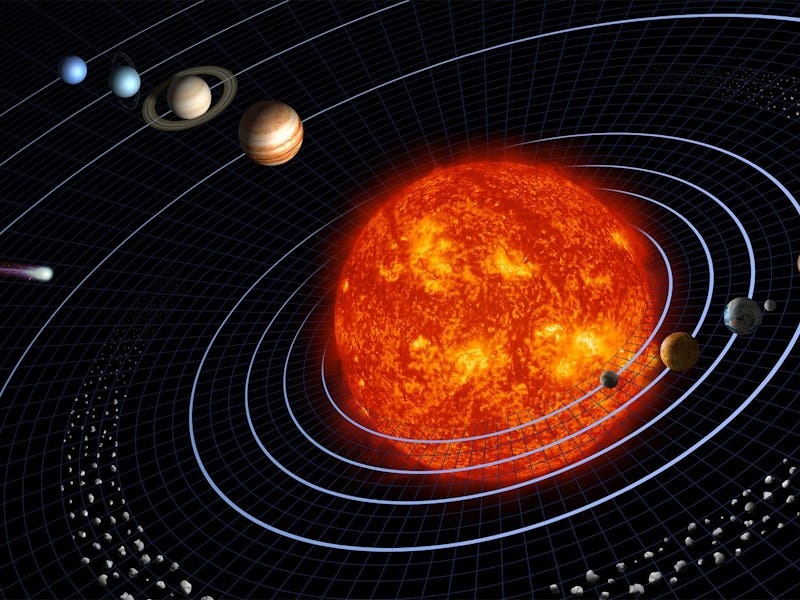What if life is a contagious, interplanetary disease?
New research tracks a rocky, interstellar object’s ability to transport life to another planet.

Around 4 billion years ago, Earth was under attack. The planet’s surface was bombarded by asteroid after asteroid and a whole host of other interstellar rocky bodies amidst the chaos of a young universe. But after this time of chaos, life — in the form of microorganisms — began to emerge.
That life could spring from a catastrophic asteroid impact may seem paradoxical, but according to one popular theory of how life arose on Earth, the two events may be far more interconnected than you might think.
The theory of panspermia suggests that life didn’t originate on Earth at all. Instead, it originated elsewhere in the universe, and was transported to our planet through interstellar objects that traveled between planetary systems — including the asteroids that smashed into Earth all those billions of years ago.
Now, scientists say they have new evidence for the theory. In the paper, they detail how a meteor’s close encounter with Earth in 2017 allowed them to calibrate the number of interstellar objects that may have carried life from our planet to another star system.
"It’s just like an infectious disease that spreads around."
“Could such an object potentially transfer life from one system to another?” Abraham Loeb, professor at Harvard University and lead author of the paper tells Inverse. “It turns out, nature is more imaginative than we are.”
The paper is currently in preprint and submitted for peer-review and publication this week.
How life spreads through the universe
The idea of life traveling between planetary systems had been on Loeb’s mind for a while before the meteor grazed the Earth’s atmosphere above Western and South Australia on July 7, 2017.
The meteor is around 30 cm in size and reached a minimum altitude of 58.5 kilometer in the atmosphere of Earth. It went from an Apollo-type orbit around the Earth to a Jupiter-family comet orbit, meaning that it got close enough to Earth to break through our atmosphere, before being deflected into Jupiter’s orbit. Finally, like a giant swatting away a gnat, Jupiter ejected it from the Solar System entirely.
The close encounter was reported in a paper published in December, 2019.
Did life travel around, infecting one planet to another?
“It’s a two-step process,” Loeb explains. “You’re using the passage close to the Earth to collect microbes, collect life, and then Jupiter gives it a kick like a racket that kicks a tennis ball.”
Based on this rocky visitor, Loeb and his colleague estimated how many other, similar objects could have exported life from Earth out from the Solar System. Once out in interstellar space, they may have been captured by another star system — potentially seeding its planets with life from Earth.
Using a method known as the Monte Carlo simulation, which models different outcomes based on the intervention of random variables, they found that, over the life of our own planetary system, up to a billion objects may have been ejected from our Solar System and captured by an exoplanetary system. And of these, as many as 1,000 of them could have carried living microbes onboard.
“If you accomplish life in one place and then you distribute it, it’s just like an infectious disease that spreads around,” Loeb says. “Once you contaminate one planetary system, it contaminates another and continues to spread throughout the galaxy.”
Where else could we infect with life?
The most likely star system to capture these bodies would be one with multiple stars, such as the Alpha Centauri system. Located only 4.37 light years away from our Solar System, Alpha Centauri is our closest neighboring star system, with three stars.
Alpha Centauri, as viewed from Chile, is our closest neighboring star system.
Emily Lakdawalla, planetary geologist at The Planetary Society, says that while it is highly likely that life may have travelled from one planet to another within our Solar System, the same isn’t true for life transferred to another star system.
“It gets more difficult if you’re going in between solar systems because of the distances involved,” Lakdawalla tells Inverse. “You’re talking about scores of living creatures remaining viable for millions of years as they transport from one solar system to another.”
With upcoming missions planned for Mars this year, Lakdawalla says it’s important to focus on finding life in our own solar system first before looking for it elsewhere.
“People want to know whether we’re the only life in the universe or not, and the first place where we should be looking is within our own solar system,” Lakdawalla says. “We got a lot of work to do here to answer that question before we wonder whether life originated somewhere else in the universe.”
“We’ve barely begun searching here,” she adds.
If we should find life on Mars, and it has the same genetic coding as life on Earth then it is still one of two possibilities, according to Lakdawalla. Life could have either traveled from one planet to another on rocky bodies such as asteroids, or life could have evolved the same way on both worlds.
Both possibilities could help us inch closer to finding out where life originated from, whether it evolved on Earth or traveled onboard a rocky visitor 4 billion years ago.
“We are looking for life elsewhere,” Loeb says. “Either it started in one place and then spread, or there is only one channel for life, one chemical path.”